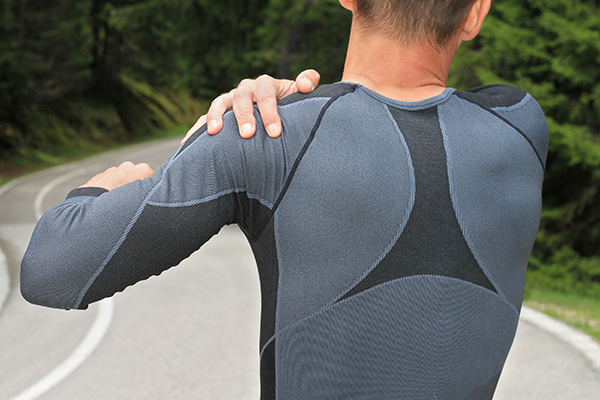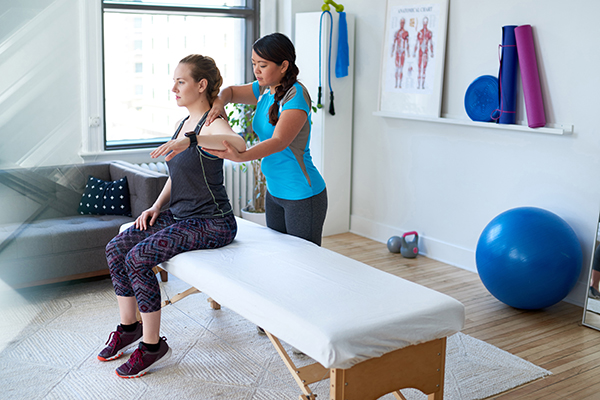How to Exercise If You Have a Shoulder Injury

Life happens, and so do injuries, but that doesn’t mean you should have to sideline your workouts entirely.
You’ve probably powered through workouts with the occasional headache or after a fitful night of sleep.
After all, workouts like LIIFT4 or 30 Day Breakaway are more than exercise. They’re stress relief, an investment in yourself, and time with a community.
But if you injure your shoulder, for example, can you (or should you) exercise?
We talked to Theresa Marko, PT, DPT, MS, a doctor of physical therapy and owner of Marko Physical Therapy in New York City, as well as Chad Kuntz, DPT, OCS, a sports physical therapist and strength and conditioning coach who runs Pr1me Movement Physical Therapy in Pineville, N.C.
They shared expert tips on how to exercise with a shoulder injury — and when to rest.

How to Exercise With a Shoulder Injury
First of all: Can you work out with a shoulder injury? That’s a question you need to answer with your doctor or physical therapist. If you get the go-ahead to work out, heed any advice or exercise limitations your medical professional recommends.
Both Marko and Kuntz underscore that the limitations are about preventing further injury to the shoulder, but the specifics depend on what’s wrong.
There are several types of shoulder injuries, so getting the bottom of what’s going on is important.
“There are actual tissue damage injuries like a torn tendon/rotator cuff, and then there are overuse injuries such as tendonitis and bursitis,” Marko explains. “There are also wear and tear injuries that come with age that can happen, such as impingement issues and osteoarthritis.”
As a starting point, you should avoid:
- Overhead pressing exercises such as the military press and shoulder press
- Incline pressing exercises such as the incline chest press
- Movements that compress the shoulder, such as the plank and downward dog
- Any dip variation
Although these are general suggestions, you might want to avoid others based on your injury.
If you feel any pain or discomfort, that’s a movement you need to avoid while you heal.
Both experts strongly suggest seeing a doctor that specializes in sports medicine, as that person will be able to assess what type of injury you have and direct you to a physical therapist that can guide you along the path to recovery.

How Can I Ease Back Into Workouts After a Shoulder Injury?
Before you can start performing shoulder workouts at home you need to correct existing mobility issues and strengthen the muscles that help move and stabilize your shoulder joint.
Ideally, you work with a physical therapist who can guide you through correct movement patterns. No matter who’s helping you heal, you need to work on mobility.
Otherwise, Marko warns, you’re “basically trying to strengthen something that can’t move, so you might tear a tendon or the shoulder labrum.” Ouch!
She also clarifies that “the only thing that heals you is your own body over time, and avoiding things that will exacerbate your injury are of the utmost importance.”
You’re going to need to take things slow, be consistent with your rehab, and ease back into workouts slowly.
Some of the key parts of post-injury recovery are accepting your situation and viewing rehab as you would training.

5 Steps for Rebuilding Shoulder Strength After an Injury
Healing looks different for everyone, but the overall process of getting back into working out after a shoulder injury is:
1. Mobilize the shoulder joint and surrounding muscles
A common problem Marko sees with shoulder dysfunction is overly tight pectoral muscles but weak upper back muscles, so you need to balance them.
2. Strengthen stabilizing muscles
A good example of this, says Kuntz, is making sure you can properly retract your shoulder blades. Strengthening this ability allows you to use your shoulder muscles more effectively during shoulder exercises.
3. Practice correct positioning and movement patterns
You might have to bring your weights down for a while once you’re recruiting the correct muscles during shoulder exercises.
Your body may have been relying on other, stronger muscles to get through the movements, Kuntz points out.
Lightening the load and focusing on the form will help prevent future injuries and actually work the muscles you’re targeting.
4. Slowly build strength through volume and load
Once you’re activating your muscles and executing movement patterns correctly, you can slowly start increasing the volume or load to build your strength back up.
You can mix it up for each workout, but increase either load or volume, not both at the same time. If you can no longer perform an exercise with correct form, it’s time to stop.
Pushing past that point increases your risk of overexertion, which can lead to injury, including strains and sprains.
5. Consistently monitor for pain or discomfort
Avoiding more injury is essential, and that requires listening to your body.
Exercises That Can Help Rehab a Shoulder Injury
Marko advises starting with exercises that move your shoulder through full ranges of motion, such as the I-Y-T shoulder raise and the 90/90 external rotation.
Skip the weights and use only your body weight to evaluate how your shoulder feels and the amount of movement you can perform safely and without pain.
Once you can move through a healthy range of motion comfortably, you can add light weights and begin performing the exercises shared here.
Other movements you can try, according to Kuntz, include face pulls using a rope, deadlifts, and bent-over dumbbell rows.
You can also include shoulder rehab exercises like pendulums, elbow flexions, and standing rows to build stabilizing strength and regain your mobility.
Side-lying external rotations
- Lie on your “good” side (opposite your injured shoulder) with your head resting on your bottom arm.
- Place a towel on your affected side and rest your elbow on it with your elbow bent 90-degrees and your forearm positioned perpendicular to the front of your body. This is the starting position.
- Keeping your elbow pressed to your side, raise your hand as high as you can toward the ceiling without discomfort or rotating the trunk of your body.
- Pause, and then return to the starting position.
- Do 20 reps, and then switch sides and repeat.
Shoulder clocks
- Lie on your “good ” side (opposite your injured shoulder) with your head resting on your bottom arm.
- Place your top arm (with the sore shoulder) along the side of your body with your hand flat and palm facing down.
- Keeping your arm straight, move it arm through an arc (leading with your thumb) from your leg to above your head, and then rotate your hand counterclockwise so that your palm now faces up.
- Now move your arm in an arc behind you (leading with your pinky) from your head to your leg.
- Rotate your hand to place your palm on your leg and return to the starting position.
- Do 20 reps, and then switch sides and repeat.
Once you can do these exercises with bodyweight, Marko suggests adding light weights to the side-lying external rotations.
This exercise involves “a very important muscle group that is small but mighty,” she says. “The rotators help to stabilize the humerus bone in the joint.”
If your rotator cuff is too weak to provide this stabilization, Marko explains, the joint will drag when you move your arm, potentially causing the tendon to pinch against the bone.
You can perform all of these exercises up to twice a day with the approval of your doctor or physical therapist.
